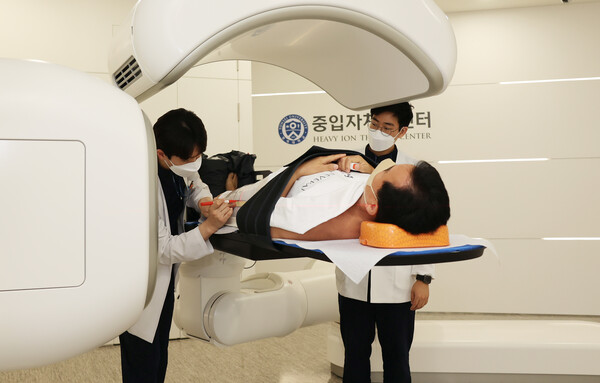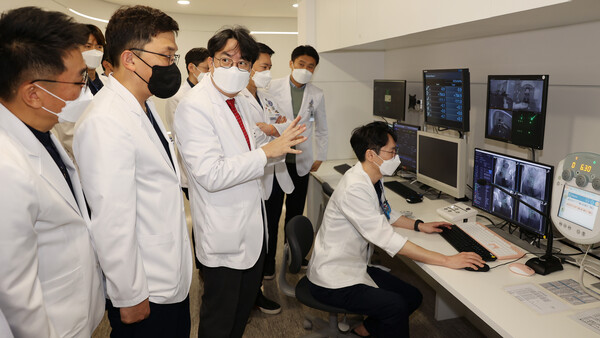The Yonsei University Health System (YUHS) said on Friday it initiated Korea’s first heavy particle therapy for a patient in his 60s suffering from stage 2 prostate cancer.
According to the YUHS, the patient was found to have a higher than normal (4 ng/ml or less) level of prostate-specific antigen (PSA) during a medical examination in 2020.
In December 2022, he was diagnosed with prostate cancer at a hospital in Seoul and was recently considering surgery.
After he visited the Yonsei Cancer Center's Heavy Particle Therapy Center, a detailed examination revealed a 1.2 cm tumor within the prostatic sheath, with no metastasis to the lymph nodes or surrounding organs.
After the first treatment, the patient said, "I thought it was only a few minutes since the treatment started, but I was surprised to hear that the treatment was already over. I could not feel any pain at all."
"I was told that there were no foods to avoid, so I plan to enjoy meals comfortably when I leave the hospital,” he added.

Short treatment time, patient convenience for daily life
Heavy particle therapy takes less than 30 minutes, including posture correction before treatment and the actual irradiation.
Because the therapy does not require hospitalization, patients can go home immediately after treatment at the center on an outpatient basis and continue their normal activities like exercise and travel.
However, because the back of the prostate is close to the anus, the patient should avoid taking a hot bath for about a month.
Not all prostate cancer patients can receive heavy particle therapy. Those with stage 4 prostate cancer and metastases are often difficult to treat. It is also difficult to use heavy particle therapy if the prostate has been surgically removed, or if the prostate has been previously treated with radiation.
Heavy particle therapy targets a mass of cancer cells, so the patient cannot receive it if the tumor is difficult to find after cancer treatment.
Therefore, only the patients who have not received any treatment after the cancer diagnosis are eligible for heavy particle therapy at Yonsei Cancer Center, the YUHS said.
Heavy particle therapy costs 55 million won with no insurance coverage
The cost of heavy particle therapy is about 55 million won ($41,067). Since it is not covered by health insurance, the patient has to pay the entire cost. The patient will receive a total of 12 treatment sessions, four times a week for three weeks.
About six to eight patients with prostate cancer can receive stationary heavy particle therapy daily.
The hospital is receiving around 150 inquiries daily, the YUHS said.

Heavy particle therapy raises the recurrence-free survival rate to more than 90 percent for high-risk patients
The advantage of heavy particle therapy for prostate cancer is its effectiveness. In Japan, which has the most experience with heavy particle therapy, about 25-30 percent of prostate cancer patients are treated with heavy particle therapy.
Prostate cancer is the second type of cancer that was covered by national health insurance in Japan.
In localized prostate cancer, the biochemical recurrence-free survival rate is one of the crucial indicators of therapeutic effects. Biochemical recurrence is defined as a rise in PSA level of more than 2 ng/ml from the lowest level recorded after treatment.
In low-risk prostate cancer with well-differentiated cancer cells, biochemical recurrence-free rates are similar for heavy particle therapy and X-ray therapy.
However, heavy particle therapy has a superior five-year biochemical recurrence-free rate in high-risk patients. Recurrence-free means that prostate cancer cells do not grow back, and in high-risk patients who are at the highest risk of recurrence, the five-year biochemical recurrence-free rate for medium-particle therapy is reported to be greater than 90 percent.
In addition, several studies have shown that heavy particle therapy demonstrated a low incidence of urinary side effects such as frequent urination, urgency, and hematuria, as well as bloody stools, which are digestive side effects that can occur with prostate cancer treatment.
"We will expand the number of cancer types that can be treated with heavy particle therapy by operating a rotating treatment machine following the fixed treatment machine we started this year," said Dr. Choi Jin-sub, head of Yonsei Cancer Center. "Yonsei Cancer Center with heavy particle therapy will take the lead in conquering cancer with various treatment options such as surgery and anticancer drugs."
Yonsei Cancer Center said it will also start operating one of the two spinning-type heavy particle therapy machines in the second half of this year.
Related articles
- YUHS to begin Korea’s 1st heavy ion therapy for cancer patients soon
- Severance Hospital finds novel biomarker for predicting gastric cancer treatment outcomes
- Severance's new Aortic Center aims to detect cardiac diseases in 'golden time'
- Russian patient with prostate cancer is 1st foreigner to receive YUHS' heavy particle therapy
- SGLT-2 inhibitor diabetes drug proves effective in alleviating NASH symptoms: study

